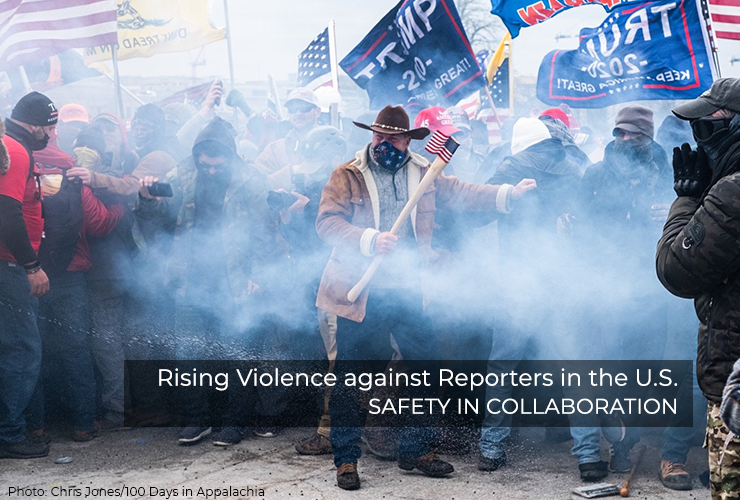Concerned about the rising violence against U.S. journalists, the North American Committee of the International Press Institute convened a virtual Town Hall meeting on January 27, 2021. It brought together a broad cross-section of organizations, and local and national journalists on the front lines, for a conversation about how they are seeing these threats, to share ideas for remedies against these threats, and to begin to build a platform for cooperation and action to counteract them.
The events of Jan. 6 in Washington crystalized the worsening atmosphere and threat to journalists in the United States from political extremists and conspiracy theorists. Words that were written on a door of the U.S. Capitol, “Murder the media,” by some of the armed protesters were a stark and frightening warning to all of us.
Outside the Capitol that day, journalists were being roughed up and suffered verbal abuse for covering the riot. Equipment was seized and vandalized.
And this kind of behavior has not been limited to Jan. 6, but across the United States there has been a pattern over the past year of demonizing and blaming journalists as if we were the opposition and the enemy — a sentiment unfortunately amplified by the last president and some allied political leaders.
Phone threats, online harassment, intimidation and physical violence used to be something we associated with other countries. This is no longer the case.
We remain fiercely proud of the courage of the U.S. press corps. By standing against violence and harassment, they are demonstrating the best of what it means to be a journalist. Their actions inspire and empower the rising generations.
We remember, too, that underlying this crisis is the challenge of trust driven, in part, by the consistent undermining of independent media by political actors. We need to ask: How do we safely find a way to begin reaching out to communities that right now are hostile to the media and enable them not just to feel represented but to be represented in our work. Not everyone is reachable. But how can we reach those who are?
Ten takeaways from IPI NAC Town Hall on journalists’ safety
These are the needs identified in the meeting:
1. January 6 is an inflection point where over 10 years of escalating attacks (both physical and digital) on both journalists and media workers and media organizations reached a critical peak. These attacks are occurring across all states and territories and involve multiple actors. They demand coordinated action by media to provide a safe working environment for U.S. media workers, both employed and freelance.
2. Physical attacks range from vandalism, through targeted violence at protests and other mass actions, on to planned anti-media terrorism by extremist groups. Although attacks are most common against large national media and in the largest media markets, journalists from local news outlets, especially those whose cameras or recording equipment makes them more conspicuous, are not immune. It should not be forgotten that the most devastating recent attack on journalists in the U.S. targeted the newsroom of a local newspaper, the Capital Gazette in Annapolis, Maryland.
3. Journalists are regularly targeted with hate attacks, including coordinated acts by both state and non-state actors. This particularly impacts women, non-binary identifiers and journalists of color. These often involve threats of physical violence and, for women and LGBTQ+ journalists, threats of sexual violence. Journalists are regularly doxed on the dark web, including with information about home addresses and family.
4. Local police often target journalists, even when wearing media identification. This is particularly concerning where it appears to be in response to accountability reporting on police actions.
5. All media organizations need to review the security of premises and ensure all staff (including regular freelance contributors) are trained for conflict reporting including active shooter drills and first aid skills. They should also work with reporters for safety plans (including escape routes) for high-risk areas, including state and local government buildings.
6. News media organizations need to step up cooperation in building a safe media ecosystem, including larger organizations supporting medium and small-sized outlets who may otherwise lack resources. Journalists across news organizations need to collaborate and support each other for safety on site of potentially violent protests.
Media organizations and J-schools need to start providing social media guidance and training that emphasizes journalist security over marketing.
7. Journalists reporting on protests and other mass actions need to plan for violence targeted at them, understanding how to “disappear” if possible, or withdraw if necessary. Reporters should develop (or formalize) buddy systems between organizations to protect each other.
8. Reporting on violent extremists requires continuing, specialist reportorial focus to build the body of expertise to inform our communities and to be forewarned of the risks media face. Journalists skilled in the beat, following the long story, are most likely to understand the threats.
9. Track and report digital abuse, by recording all instances, particularly when it involves real or implied threats of violence. Digital abuse can be a precursor to physical violence.
10. Wherever possible, media should work with law enforcement (particularly domestic law enforcement agencies such as the FBI) to report all threats and to help identify potential threats. We recognize this is a complicated reality and that, after well-documented police harassment of journalists at work this year, there is much work to be done to rebuild respect for journalism among law enforcement. News media need to also work with social media platforms to identify and remove material that is dangerous for journalists.
Thanks to the organizations that joined the Town Hall and helped create the conversation and with whom we will continue to collaborate: The National Press Club, The Overseas Press Club, The GroundTruth Project and Report for America, The Dart Center, the ACOS Alliance, PEN America, the Radio Television Digital News Association and The Committee to Protect Journalists.



